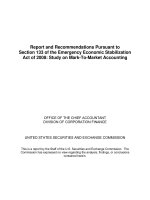krugman - the return of depression economics and the crisis of 2008 (2009)
Bạn đang xem bản rút gọn của tài liệu. Xem và tải ngay bản đầy đủ của tài liệu tại đây (2.86 MB, 205 trang )
PAUL KRUGMAN
WINNER OF THE
NOBEL
PRIZE IN
ECONOMICS
THE
RETURN
OF
DEPRESSION
ECONOM
CS
AND THE
CRISIS
OF I 2008
ISBN
978-0-393-07101-6 USA $24.95
CAN.
$27.50
W
hat better guide could we have to
the
2008
financial crisis and its
resolution than our newest Nobel
Laureate
in Economics, the prolific
columnist and author Paul Krugman? In
his prescient 1999 classic, The
Return
of
Depression
Economics,
Krugman surveyed
the economic crises
that
had swept across
Asia
and Latin America and pointed out
that
they
were a warning for all of us:
like
diseases
that
have become resistant to antibiotics, the
economic maladies
that
caused the Great
Depression
were making a comeback. In the
years
that
followed, as Wall Street boomed and
financial wheeler-dealers made vast profits,
the international crises of the
1990s
faded
from memory. But now depression economics
has
come to America. When the great housing
bubble of the
mid-2000s
burst, the U.S.
financial system proved as vulnerable as those
of developing countries caught up in earlier
crises—and
a replay of the
1930s
seems all
too possible.
In this new, greatly updated edition
of The
Return
of
Depression
Economics,
Krugman
shows how the failure of regulation to
keep
pace with an increasingly out-of-control
financial system set the United States and the
world up for the greatest financial crisis since
the
1930s.
He also lays out the steps
that
must be taken to contain the crisis and turn
around a world economy
sliding
into a deep
recession.
Brilliantly crafted in Krugman's
trademark style—lucid, lively, and supremely
informed—this new edition of The
Return
of
Depression
Economics
will
become an instant
cornerstone
of the debate over how to respond
to the crisis. ».
PAUL
KRUGMAN is the recipient of the
2008
Nobel Prize in Economics. A
prolific
author, columnist, and blogger, he teaches
economics and international affairs at
Princeton University.
JACKET
DESIGN
BY GRAY318
AUTHOR
PHOTOGRAPH
IY IAN
IEITCN
PRINTED
IN
THE UNITED STATES
OF
AMERICA
BUSINESS/ECONOMICS
Our
newest
Nobel
Prize-winning
economist
shows
how
today's
crisis
parallels
the
events
that
caused
the
Great
Depression—
and
explains
what
it
will
take
to
avoid
catastrophe.
FROM THE INTRODUCTION
Most
economists, to the extent
that
they think about the
subject at all, regard the Great Depression of the
1930s
as a
gratuitous, unnecessary tragedy. If only Herbert Hoover hadn't
tried to balance the budget in the face of an economic slump;
if only the Federal Reserve hadn't defended the gold standard
at the expense of the domestic economy; if only officials had
rushed cash to threatened banks, and thus calmed the bank
panic
that
developed in
1930-31
;
then the stock market crash
of 1929 would have led only to a garden-variety recession,
soon
forgotten. And since economists and policymakers have
learned their lesson nothing like the Great Depression can
ever
happen again.
Or
can it?
THE
RETURN OF
DEPRESSION ECONOMICS
AND THE CRISIS OF 2008
The
Conscience
of
a
Liberal
The
Great Unraveling
Fuzzy Math
The
Accidental Theorist
Pop Internationalism
Peddling Prosperity
The
Age
of
Diminished Expectations
Krugman
THE
RETURN OF
DEPRESSION ECONOMICS
AND THE CRISIS OF 2 008
W.
W.
Norton
&
Company
New
York London
Copyright ©
2009, 1999
by Paul Krugman
All
rights reserved
Printed in the United States
of
America
First
Edition
For
information about permission to reproduce selections from this book,
write to Permissions,
W. W.
Norton & Company, Inc.,
500
Fifth Avenue, New
York,
NY
10110
For
information about special discounts for bulk purchases, please contact
W.
W. Norton Special
Sales
at
or
800-233-4830
Manufacturing by
The
Courier Companies, Inc.
Production managers: Andrew Marasia and Sue Carlson
ISBN 978-0-393-07101-6
W. W.
Norton & Company, Inc.
500
Fifth Avenue, New
York,
N.Y.
10110
www.wwnorton.com
W.
W. Norton & Company Ltd.
Castle
House,
75/76
Wells
Street, London WIT 3QT
1234567890
Contents
INTRODUCTION 3
1 "THE CENTRAL PROBLEM HAS BEEN SOLVED" 9
2 WARNING IGNORED: LATIN AMERICAS CRISES 30
3 JAPAN'S TRAP 56
4
ASIA'S
CRASH 77
5 POLICY
PERVERSITY
101
6 MASTERS OF THE UNIVERSE 119
7 GREENSPAN'S BUBBLES 139
8 BANKING IN THE
SHADOWS
153
9 THE SUM OF ALL FEARS 165
10 THE RETURN OF DEPRESSION ECONOMICS 181
RETURN OF
DEPRESSION ECONOMICS
AND THE CRISIS OF 2008
ost economists, to the extent that they think about
the subject at all, regard the Great Depression of the
1930s
as a gratuitous, unnecessary tragedy. If
only
Herbert
Hoover hadn't tried to balance the budget in the face of
an economic slump; if
only
the Federal Reserve hadn't defended
the
gold
standard at the expense of the domestic economy; if
only
officials had rushed cash to threatened banks, and thus calmed
the bank panic that
developed
in
1930-31;
then the stock
mar-
ket crash of 1929
would
have led
only
to a garden-variety reces-
sion,
soon
forgotten. And since economists and policymakers
have learned their
lesson—no
modern treasury secretary
would
echo Andrew Mellon's famous advice to "liquidate labor, liquidate
stocks, liquidate the farmers, liquidate real estate . . . purge the
rottenness out of the system"—nothing
like
the Great Depression
can
ever happen again.
3
4
The Return of Depression Economics
Or
can it? In the late 1990s a group of Asian economies—
economies that produced about a quarter of the world's output and
were home to two-thirds of a
billion
people—experienced an eco-
nomic slump that bore an eerie resemblance to the Great Depres-
sion. Like the Depression, the crisis
struck
out
of
a
clear
blue sky, with
most pundits predicting a continuing boom even as the slump gath-
ered
momentum; as in the 1930s the conventional economic medi-
cine proved ineffective, perhaps even counterproductive. The fact
that
something
like
this could happen in the modern world should
have sent chills up the spine of anyone with a sense of history.
It
certainly sent chills up my spine. The first edition of this book
was written in response to the Asian crisis of the
1990s.
Where
some saw the crisis as a specifically Asian phenomenon, I saw it
as
a troubling omen for all of us, a warning that the problems of
depression economics have not disappeared in the modern world.
Sad to say, I was right to be worried: as this new edition goes to
press,
much
of
the world, very much including the United States, is
grappling with a financial and economic crisis that bears even more
resemblance to the Great Depression than the Asian troubles of
the
1990s.
The
kind of economic trouble that Asia experienced a decade
ago,
and that we're all experiencing now, is precisely the sort of
thing we thought we had learned to prevent. In the bad old days
big, advanced economies with stable governments—like Britain
in the 1920s—might have had no answer to prolonged periods of
stagnation and deflation; but between John Maynard Keynes and
Milton Friedman, we thought we knew enough to keep that from
happening again. Smaller countries—like Austria in 1931—may
once have been at the mercy of financial tides, unable to control
their
economic destiny; but nowadays sophisticated bankers and
government officials (not to mention the International Monetary
INTRODUCTION
5
Fund)
are supposed to quickly orchestrate rescue packages that
contain such crises before they spread. Governments—like that of
the United States in 1930-31—may once have stood by
helplessly
as national banking systems collapsed; but in the modern world,
deposit insurance and the readiness of the Federal Reserve to
rush cash to threatened institutions are supposed to prevent such
scenes. No
sensible
person thought that the age of economic anxi-
ety was past; but whatever problems we might have in the future,
we were sure that they
would
bear little resemblance to those of
the 1920s and
1930s.
But
we
should
have realized a decade ago that our confidence
was misplaced.
Japan
spent most of the 1990s in an economic
trap
that
Keynes and his contemporaries found completely familiar. The
smaller economies of Asia, by contrast, went from boom to calam-
ity virtually overnight—and the story of their calamity reads as if it
were taken straight out of a financial history of the
1930s.
At the time, I thought of it this way: it was as if bacteria that
used to cause deadly plagues, but had
long
been
considered con-
quered by modern medicine, had reemerged in a form resistant to
all the standard antibiotics. Here's what I wrote in the introduction
to the first edition: "So far
only
a limited number of people have
actually
fallen
prey to the
newly
incurable strains; but
even
those
of
us who have so far
been
lucky
would
be
foolish
not to seek new
cures,
new prophylactic regimens, whatever it takes,
lest
we turn
out to be the next victims."
Well, we were
foolish.
And now the plague is upon us.
Much of this new
edition
is devoted to the Asian crisis of the
1990s,
which turns out to have
been
a sort of rehearsal for the
global crisis now in progress. But I've added a lot of new material
as
well,
in an effort to explain how the United States found itself
looking
like
Japan
a decade earlier, how Iceland found itself look-
6
The Return of Depression Economics
ing
like
Thailand, and how the original crisis countries of the 1990s
have,
to their
horror,
found themselves once again at the edge of
the abyss.
About This Book
Let
me admit at the outset that this book is, at bottom, an ana-
lytical
tract.
It is not so much about
what
happened as why it hap-
pened; the important things to understand, I believe, are how this
catastrophe
can have happened, how the victims can recover, and
how we can prevent it from happening again. This means that the
ultimate objective is, as they say in business schools, to develop the
theory
of the case—to figure out how to think about this stuff.
But
I have tried to avoid making this a dry theoretical exposi-
tion. There are no equations, no inscrutable diagrams, and (I hope)
no impenetrable jargon. As an economist in good standing, I am
quite capable of writing things nobody can read. Indeed, unread-
able writing—my own and others'—played a key role in helping me
arrive
at the
views
presented here. But what the world needs now
is informed action; and to get that kind of action, ideas must be
presented in a way that is accessible to concerned people at large,
not just those with economics Ph.D.'s. Anyway, the equations and
diagrams
of formal economics are, more often than not, no more
than
a scaffolding used to help construct an intellectual edifice.
Once
that edifice has been built to a certain point, the scaffolding
can
be stripped away, leaving only plain English behind.
It
also turns out that although the ultimate goal here is analyti-
cal,
much of the writing involves narrative. Partly this is because
the story line—the sequence in which events happened—is often
an
important clue to what theory of the case makes sense. (For
example,
any "fundamentalist"
view
of economic crisis—that is, a
INTRODUCTION
7
view
that economies only get the punishment they deserve—must
come
to grips with the peculiar coincidence that so many seemingly
disparate
economies hit the wall in the space of a few months.)
But
I am also aware that the story line provides a necessary con-
text
for any attempts at explanation and that most people have not
spent the last eighteen months obsessively
following
the unfolding
drama.
Not everyone recalls what Prime Minister Mahathir said
in Kuala Lumpur in August 1997 and relates it to what Donald
Tsang
ended up doing in Hong Kong a year
later;
well,
this book
will
refresh your memory.
A note about intellectual style: one temptation that often afflicts
writers
on economics, especially when the subject is so grave, is the
tendency to become excessively dignified. Not that the events we
are
concerned with aren't important, in some cases matters of
life
and
death. Too often, though, pundits imagine that because the
subject
is serious, it must be approached solemnly: that because
these are big issues, they must be addressed with big words; no
informality or levity allowed. As it turns out, however, to make
sense of new and strange phenomena, one must be prepared to
play with ideas. And I use the word "play" advisedly: dignified peo-
ple, without a whimsical streak, almost never offer fresh insights,
in economics or anywhere else. Suppose I tell you that
"Japan
is suffering from fundamental maladjustment, because its state-
mediated growth model leads to
structural
rigidity." Well, guess
what: I haven't said anything at all; at best I have conveyed a sense
that
the problems
are
very
difficult, and
there
are
no easy answers—a
sense that may
well
be completely wrong. Suppose, on the other
hand,
that I illustrate
Japan's
problems with the entertaining tale of
the
ups and downs of a baby-sitting co-op (which
will,
in fact, make
8
The
Return of Depression Economics
several
appearances
in this book). Maybe it sounds
silly,
maybe the
levity
will
even offend your sensitivities, but the whimsicality has
a
purpose: it jolts the mind into a different channel, suggesting in
this case that there may indeed be a surprisingly easy way out of at
least
part
of
Japan's
problem. So don't expect a solemn, dignified
book: the objectives here are as serious as can be, but the writing
will
be as
silly
as the subject demands.
And with
that,
let's begin our
journey,
starting with the world as
it seemed to be, just a few
years
ago.
1
"THE
CENTRAL
PROBLEM
HAS
BEEN
SOLVED"
n
2003
Robert
Lucas,
a professor at the University of Chicago
and
winner of the 1995 Nobel Memorial Prize in Economics,
gave the presidential address at the annual meetings of the
American
Economic Association. After explaining that macroeco-
nomics began as a response to the Great Depression, he declared
that
it was time for the
field
to move on: the "central problem of
depression-prevention," he declared, "has been solved, for all
prac-
tical
purposes."
Lucas
didn't claim that the business cycle, the irregular alterna-
tion of recessions and expansions that has been with us for at least
a
century and a half, was over. But he did claim that the cycle had
been tamed, to the point that the benefits of any further taming
were
trivial:
smoothing out the
wiggles
in the economy's growth, he
argued,
would
produce only
trivial
gains in public welfare. So it was
time to switch focus to things
like
long-term economic growth.
9
io
The Return of Depression Economics
Lucas
wasn't alone in claiming that depression-prevention was
a
solved problem. A year later Ben Bernanke, a former
Prince-
ton professor who had gone to serve on the board of the Federal
Reserve—and
would soon be appointed as the Fed's chairman—
gave a remarkably upbeat speech titled "The
Great
Moderation,"
in which he argued, much as
Lucas
had, that modern macroeco-
nomic policy had solved the problem of the business cycle—or,
more
precisely, reduced the problem to the point that it was more
of
a nuisance than a front-rank issue.
Looking back from only a few
years
later,
with much of the world
in the throes of a financial and economic crisis all too reminis-
cent
of the
1930s,
these optimistic pronouncements sound almost
incredibly smug. What was especially strange about this optimism
was the fact that during the
1990s,
economic problems reminiscent
of
the
Great
Depression had, in fact, popped up in a number of
countries—including
Japan,
the world's second-largest economy.
But
in the early years of this decade, depression-type problems
had
not yet hit the United States,
while
inflation—the scourge of
the
1970s—seemed, finally, to be
well
under control. And the
rela-
tively soothing economic
news
was embedded in a political context
that
encouraged optimism: the world seemed more favorable to
market
economies than it had for almost ninety years.
Capitalism
Triumphant
This is a book about economics; but economics inevitably takes
place
in a political context, and one cannot understand the world
as
it appeared a few years ago without considering the fundamen-
tal
political fact of the
1990s:
the collapse of socialism, not merely
as
a ruling ideology, but as an idea with the power to move men's
minds.
"THE
CENTRAL
PROBLEM
HAS
BEEN
SOLVED" 11
That
collapse began,
rather
oddly, in China. It is
still
mind-
boggling
to realize that
Deng
Xiaoping launched his nation on
what turned out to be the road to capitalism in 1978, only three
years
after the Communist victory in Vietnam, only two years after
the internal defeat of radical Maoists who wanted to resume the
Cultural
Revolution. Probably
Deng
did not
fully
realize how far
that
road
would
lead; certainly it took the rest of the world a
long
time to grasp that a
billion
people had quietly abandoned Marxism.
In fact, as late as the early 1990s China's transformation had failed
fully
to register with the chattering classes; in the best-sellers of the
time, the world economy was an arena for "head to head" struggle
between Europe, America, and
Japan—China
was thought of, if at
all, as a subsidiary player, perhaps
part
of an emerging yen bloc.
Nonetheless, everyone realized that something had changed,
and that "something" was the collapse of the Soviet Union.
Nobody really understands what happened to the Soviet regime.
With
the benefit of hindsight we now think
of
the
whole
structure
as
a
sort of
ramshackle
affair, doomed to eventual failure. Yet this was
a
regime that had maintained its grip through civil war and fam-
ine, that had been able against terrible odds to defeat the Nazis,
that
was able to mobilize the scientific and industrial resources to
contest America's nuclear superiority. How it could have ended so
suddenly, not with a bang but with a whimper, should be regarded
as
one of the great puzzles of political economy. Maybe it was
simply a matter of time—it seems that revolutionary fervor, above
all the
willingness
to murder your opponents in the name of the
greater
good, cannot last more than a couple of generations. Or
maybe the regime was gradually undermined by the stubborn
refusal of capitalism to display the proper degree of decadence: I
have a private theory, based on no evidence whatsoever, that the
rise
of Asia's capitalist economies subtly but deeply demoralized
12
The Return of Depression Economics
the
Soviet regime, by making its claim to have history on its side
ever
less
plausible. A debilitating, unwinnable war in Afghanistan
certainly
helped the process along, as did the evident inability of
Soviet industry to match Ronald Reagan's
arms
buildup. Whatever
the
reasons, in 1989 the Soviet empire in
Eastern
Europe suddenly
unraveled,
and in 1991 so did the Soviet Union
itself.
The
effects of that unraveling were
felt
around the world, in
ways obvious and subtle. And all of the effects were favorable to
the
political and ideological dominance of capitalism.
First
of all, of course, several hundred
million
people who had
lived
under Marxist regimes suddenly became citizens of states
prepared
to give markets a chance. Somewhat surprisingly, how-
ever,
this has in some ways turned out to be the least important
consequence of the Soviet collapse.
Contrary
to what most people
expected,
the "transition economies" of
Eastern
Europe did not
quickly become a
major
force in the world market, or a favored
destination for foreign investment. On the
contrary,
for the most
part
they had a very hard time making the transition:
East
Ger-
many,
for example, has become Germany's equivalent of Italy's
Mezzogiorno, a permanently depressed region that is a continual
source
of social and fiscal concern. Only now, almost two decades
after
the fall of Communism, are a few countries—Poland,
Esto-
nia,
the Czech Republic—starting to look
like
success stories. And
Russia
itself has become a surprisingly powerful source of financial
and
political instability for the rest of the world. But let's reserve
that
story for Chapter 6.
Another
direct effect of the collapse of the Soviet regime was
that
other governments that had relied on its largesse were now on
their
own. Since some of these states had been idealized and idol-
ized
by opponents of capitalism, their sudden poverty—and the
corresponding
revelation of their previous dependency—helped
"THE
CENTRAL
PROBLEM
HAS
BEEN
SOLVED" 13
to
undermine the legitimacy of all such movements. When Cuba
seemed a heroic nation, standing alone with clenched
fist
confront-
ing the United States, it was an
attractive
symbol for revolutionar-
ies across Latin
America—far
more
attractive,
of course, than the
gray
bureaucrats
of Moscow. The shabbiness of post-Soviet Cuba
is not only
disillusioning
in
itself;
it makes painfully clear that the
heroic
stance of the past was possible only because of huge subsi-
dies
from those very
bureaucrats.
Similarly, until the
1990s
North
Korea's
government, for all its ghastliness, held a certain mystique
for
radicals, particularly among South Korean students. With its
population literally starving because it no longer receives Soviet
aid,
the thrill is gone.
Yet
another more or
less
direct effect of Soviet collapse was
the
disappearance of the many radical movements that, what-
ever
their claims to represent a
purer
revolutionary spirit, were in
fact
able to operate only because Moscow provided the weapons,
the
training camps, and the money. Europeans
like
to point out
that
the radical terrorists of the seventies and eighties—Baader-
Meinhof in Germany, the Red Army Brigades in Italy—all claimed
to
be
true
Marxists, unconnected with the
corrupt
old Commu-
nists in Russia. Yet we now know that they were deeply depen-
dent on Soviet-bloc aid, and as soon as that aid vanished, so did
the
movements.
Most of
all,
the humiliating failure
of
the
Soviet Union destroyed
the
socialist dream.
For
a century and a
half
the
idea of socialism—
from
each according to his abilities, to each according to his
needs—served as an intellectual focal point for those who dis-
liked
the hand the market dealt them. Nationalist leaders invoked
socialist ideals as they blocked foreign investment or repudiated
foreign debts; labor unions used the rhetoric of socialism as they
demanded higher wages; even businessmen appealed to vaguely









